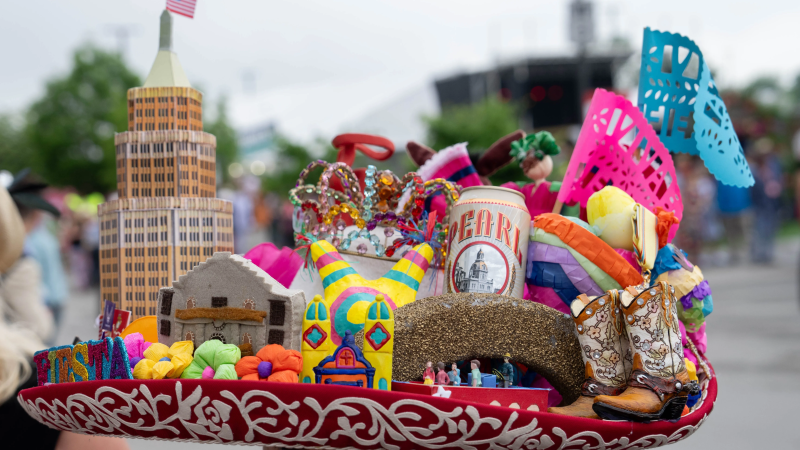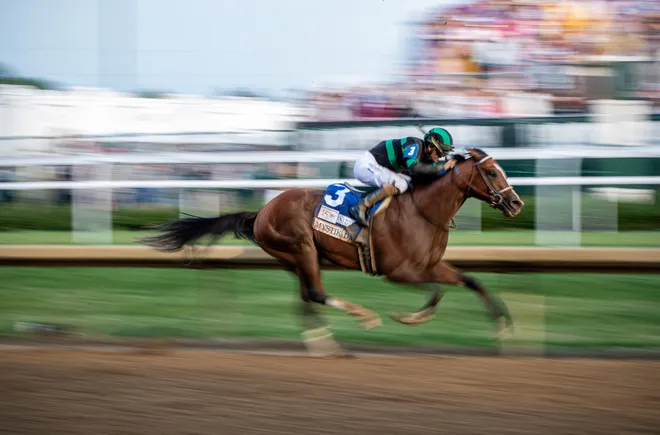Derby was electric, but if horses keep skipping Preakness, Triple Crown loses relevance

Despite much of the gloom and doom that bubbles into the narrative any time horse racing takes the national stage, last weekend was an undeniably good one for the sport.
Television ratings for the 150th Kentucky Derby were the best since 1989, with a peak of more than 20 million people tuning in to watch the thrilling, three-horse photo finish with Mystik Dan beating Sierra Leone by a nose. The Derby drew a record $198.3 million in wagers, with nearly $320 million bet in total on the 14-race card at Churchill Downs.
And perhaps most important of all, the week went off without any breakdowns or horse deaths, which might be coincidence but could also be evidence that new federally mandated safety protocols implemented over the last year are working. We’ll see.
The bottom line is that, despite racing’s decline as a major mainstream sport, people still like watching and betting on horses – particularly around days that feel like big events.
But the elation surrounding Derby Day is about to once again run into the sport’s annual comedown: The Preakness.

That’s not a shot at the race itself or even the notoriously dilapidated condition of Baltimore’s Pimlico Race Course (more on that in a moment).
If horse racing were optimized to retain the interest of those 20 million who watched last weekend, the Preakness would be where all the storylines people learn about in the Derby end up converging: Can Mystik Dan do it again and set up a possible Triple Crown? How will Sierra Leone bounce back from a heartbreaking defeat? Will there be redemption for beaten favorite Fierceness?
Instead, it’s possible none of the main characters from the Derby will show up in Baltimore – including Mystik Dan, whose trainer, Ken McPeek, has been noncommittal to the point of seeming unenthusiastic about turning around just two weeks later for the Preakness.
“I ran him back once in two weeks and it completely backfired on me,” McPeek told reporters Sunday. “So we'll just watch him, and we’ll probably take it up to the last minute.”
Though McPeek’s tone was a bit more optimistic on Wednesday, it’s not hyperbole to suggest that the Preakness becomes a sporting irrelevance if Mystik Dan doesn’t show up. And it would be the second time in three years the Derby winner has skipped the second jewel of the Triple Crown, following Rich Strike’s absence in 2021.
Regardless of McPeek's decision, the days of horsemen automatically sending their Derby winners to Baltimore appear to be over. They’re sending the Triple Crown a message. Maybe it's time the sport’s stakeholders listen?
For at least 15 or 20 years, as horses run fewer races and trainers prefer to give them more time in between to recover, spacing out the Triple Crown races has been a hot topic within the industry. It became especially in vogue to bring it up during the 37-year Triple Crown drought after Affirmed in 1978, with 13 horses subsequently winning the first two legs and then coming up short in the Belmont.
But American Pharoah (2015) and Justify (2018) proved that the Triple Crown was still possible, reinforcing the idea that it should be really, really hard to join one of the most exclusive clubs in sports. For a few years, at least, talk of changing the format waned.
The question, though, shouldn’t be whether the Triple Crown is too hard or too easy to win. It should be what can best sustain interest in a sport that doesn’t have many big days on the national stage.
Is it good for the sport that Todd Pletcher and Chad Brown, who usually come to the Derby with multiple contenders, go back to New York and wait for the Belmont? Is it good for the sport that, as of now, the only Derby horse who seems likely to run in the Preakness is 17th-place finisher Just Steel? Is it good for the sport that we could regularly have Derby winners waffling about whether it's worth trying for the Triple Crown?
Though the number has always fluctuated a bit year-to-year, the 20 Preaknesses run between 1994 and 2013 included an average of 5.45 horses from the Derby. Over the last 10 years, however, that number has dropped to 3.6.
Last year, only Kentucky Derby winner Mage ran in both races – and the rest of his career was plagued by physical problems until he was retired last November, having only run twice more after the Triple Crown.
Though every horse is different and some handle a rigorous schedule better than others, this is why trainers have increasingly leaned toward being conservative. If they want a fresh, fit horse for big races in the summer and fall, it just doesn’t make a lot of sense anymore to send them out for a 1 3/16-mile race just 14 days after a hard 1 1/4-mile race.
In talking with reporters Wednesday, McPeek even brought up the example of his first Derby starter, Tejano Run, who finished second in 1995. Two weeks later, the horse finished a dull ninth at Pimlico and wasn’t heard from again until the following year.
“As a young trainer, I wish I could have a do-over," McPeek said. “I wouldn’t have run him.”
There’s lots of blame for this state of affairs, starting with a breeding industry that has evolved American racehorses into a weaker, less-sound animal. But pining for the days of Count Fleet and Whirlaway – who each ran in and won a race between the Preakness and Belmont in the 1940s – isn’t going to change these trends.
And Pimlico is the one paying the price, which is crucial at the moment given that the state of Maryland is set to assume ownership of the track as part of a legislative proposal that would direct $400 million in state bond money to rebuild it and make it the year-round home of Maryland racing. Without those major upgrades, the future of the Preakness being a Baltimore event would be very much up in the air.
Though Maryland legislators will call it economic development, it’s also a significant bet on the Preakness. But if the Preakness is no longer a race that the owners and trainers of the top 3-year-olds care about, how can you justify pouring that kind of money into it?
For the sake of the race itself, and sustaining any type of interest in the Triple Crown, it’s time to finally think about spacing the races a month apart. If you ran the Derby on the first Saturday in May, the Preakness on the first Saturday in June and the Belmont on the first Saturday in July, there’s no doubt more horses would run in all three.
“They should seriously consider it,” McPeek said. “What’s the big deal on shifting it a little bit? It would be better for the sport.”
Of course, it would require Pimlico and the New York Racing Association working together to align the dates. Television networks would also have a say. Nothing in horse racing changes quickly or easily.
But the will-he-or-won’t-he drama around Mystik Dan's participation is a flashing neon sign for a sport that should be riding the momentum of an epic Derby weekend.
The Preakness, and thus the Triple Crown, is in real trouble of maintaining its relevance. There’s a solution that would be better for both fans and the health of the animals. It’s time for horse racing to ditch tradition and do the obvious thing to fix one of its most valuable brands.
Disclaimer: The copyright of this article belongs to the original author. Reposting this article is solely for the purpose of information dissemination and does not constitute any investment advice. If there is any infringement, please contact us immediately. We will make corrections or deletions as necessary. Thank you.







